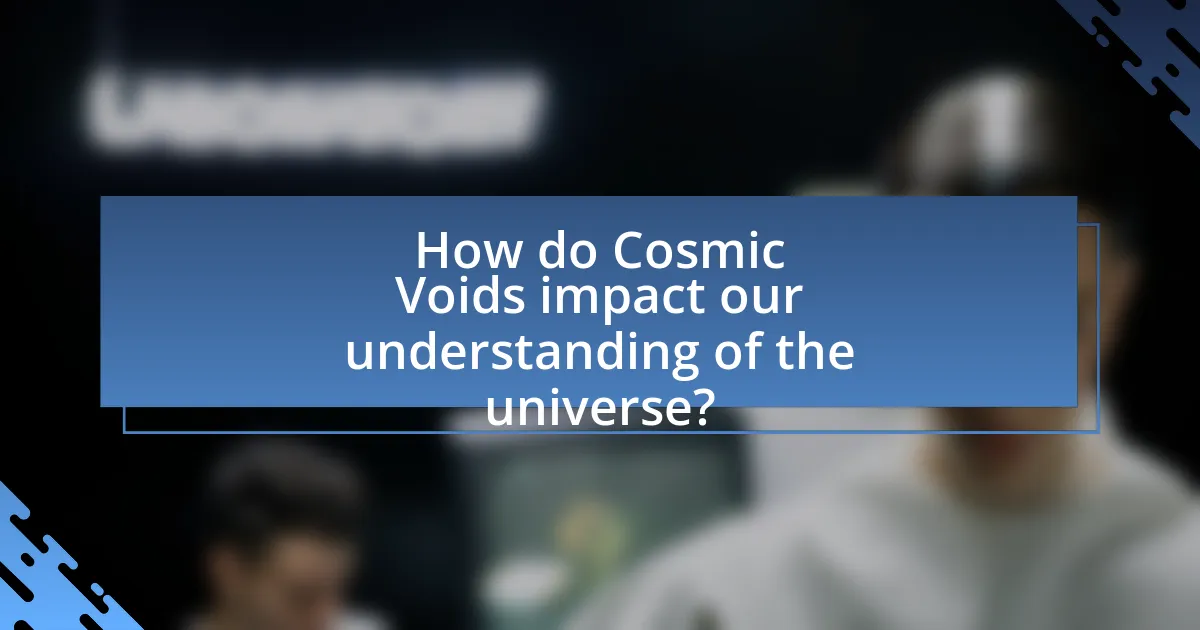Cosmic voids are vast, nearly empty regions of space that contain significantly fewer galaxies than denser areas, making up about 80% of the universe’s volume. This article explores the definition, characteristics, and significance of cosmic voids in astrophysics, detailing how they influence the large-scale structure of the universe, galaxy formation, and the distribution of dark matter. It also examines the methods used to identify and measure these voids, recent discoveries reshaping our understanding of their role, and the implications for cosmology, including their effects on theories of dark matter and dark energy. Additionally, advancements in technology and observational techniques, such as the Sloan Digital Sky Survey, have enhanced the study of cosmic voids, providing critical insights into the universe’s evolution and structure.

What are Cosmic Voids?
Cosmic voids are vast, nearly empty regions of space that contain very few galaxies compared to denser areas of the universe. These structures can span tens to hundreds of millions of light-years and are a significant component of the large-scale structure of the cosmos. Research indicates that cosmic voids make up about 80% of the universe’s volume, highlighting their prevalence and importance in understanding cosmic evolution and the distribution of matter.
How are Cosmic Voids defined in astrophysics?
Cosmic voids in astrophysics are defined as large, underdense regions of space that contain significantly fewer galaxies than the average density of the universe. These voids can span tens to hundreds of millions of light-years across and are a crucial component of the large-scale structure of the universe, often surrounded by denser regions known as filaments and clusters. Observational studies, such as those conducted by the Sloan Digital Sky Survey, have quantified these voids, revealing that they make up about 80% of the volume of the universe, thereby highlighting their importance in understanding cosmic evolution and the distribution of matter.
What characteristics distinguish Cosmic Voids from other cosmic structures?
Cosmic Voids are characterized by their vast, nearly empty regions of space that contain significantly fewer galaxies than average, distinguishing them from other cosmic structures. Unlike galaxy clusters or filaments, which are densely populated with matter, Cosmic Voids can occupy up to 80% of the universe’s volume and have a density that is about 20% of the average cosmic density. This stark contrast in density and structure highlights their unique role in the cosmic web, where they serve as the large-scale framework of the universe, influencing galaxy formation and distribution. Studies, such as those conducted by the Sloan Digital Sky Survey, have quantitatively mapped these voids, confirming their size and density characteristics, thus validating their distinction from other cosmic structures.
What methods are used to identify and measure Cosmic Voids?
Cosmic voids are identified and measured primarily through observational techniques such as galaxy surveys and simulations. Galaxy surveys, like the Sloan Digital Sky Survey, map the distribution of galaxies in the universe, allowing researchers to detect underdense regions indicative of voids. Additionally, simulations of cosmic structure formation help predict the size and shape of voids based on the distribution of dark matter and baryonic matter. These methods have been validated through statistical analyses that compare observed galaxy distributions with theoretical models, confirming the existence and characteristics of cosmic voids.
Why are Cosmic Voids significant in the universe?
Cosmic voids are significant in the universe because they provide insights into the large-scale structure of the cosmos and the distribution of dark matter. These vast, empty regions, which can comprise up to 80% of the universe’s volume, help astronomers understand the formation and evolution of galaxies. Studies, such as those conducted by the Sloan Digital Sky Survey, reveal that the presence and characteristics of cosmic voids correlate with the underlying matter density, thus offering evidence for the existence of dark energy and influencing models of cosmic expansion.
How do Cosmic Voids influence the large-scale structure of the universe?
Cosmic voids influence the large-scale structure of the universe by acting as regions of underdensity that shape the distribution of galaxies and dark matter. These voids, which occupy about 80% of the universe’s volume, create gravitational wells that affect the motion of surrounding matter, leading to the formation of filaments and clusters of galaxies. Research indicates that the presence of cosmic voids alters the cosmic web structure, as galaxies tend to avoid these low-density areas, resulting in a more filamentary arrangement of matter. Studies, such as those conducted by Pan et al. (2012) in “The Cosmic Web: Structure and Dynamics,” demonstrate that voids play a crucial role in the evolution of the universe’s large-scale structure by influencing galaxy formation and distribution patterns.
What role do Cosmic Voids play in the distribution of galaxies?
Cosmic voids play a crucial role in the distribution of galaxies by influencing their spatial arrangement and density. These vast, empty regions of space, which can be millions of light-years across, create a gravitational framework that affects how galaxies cluster and form. Research indicates that galaxies tend to be found in denser regions, such as filaments and clusters, while voids are largely devoid of galaxies, leading to a cosmic web structure. Observations from the Sloan Digital Sky Survey reveal that about 80% of the universe’s volume is occupied by these voids, highlighting their significance in shaping the large-scale structure of the universe.

What discoveries have been made regarding Cosmic Voids?
Cosmic voids are large, underdense regions in the universe that have been found to significantly influence cosmic structure and evolution. Recent discoveries indicate that these voids contain less than 10% of the average density of matter in the universe, which affects the distribution of galaxies and dark matter. Studies, such as those using data from the Sloan Digital Sky Survey, have revealed that voids can impact galaxy formation and clustering, leading to insights about the large-scale structure of the universe. Additionally, research has shown that cosmic voids may play a role in the acceleration of cosmic expansion, as their gravitational effects can influence the dynamics of surrounding matter.
How have advancements in technology contributed to the discovery of Cosmic Voids?
Advancements in technology have significantly enhanced the discovery of cosmic voids by improving observational capabilities and data analysis methods. High-resolution telescopes, such as the Sloan Digital Sky Survey (SDSS), have allowed astronomers to map large-scale structures in the universe, revealing the existence and distribution of these vast, empty regions. Additionally, advancements in computational techniques, including machine learning algorithms, have enabled researchers to analyze massive datasets more efficiently, identifying voids with greater accuracy. For instance, the SDSS has cataloged over 1.5 million galaxies, providing critical data that supports the understanding of cosmic voids and their role in the large-scale structure of the universe.
What telescopes and surveys have been pivotal in these discoveries?
The pivotal telescopes and surveys in the discovery of cosmic voids include the Sloan Digital Sky Survey (SDSS) and the Hubble Space Telescope. The SDSS has mapped large areas of the sky, providing extensive data on galaxy distributions, which revealed the existence of vast empty regions in the universe known as cosmic voids. The Hubble Space Telescope has contributed to understanding the structure of these voids by capturing high-resolution images of galaxies at various distances, allowing astronomers to analyze the effects of cosmic voids on galaxy formation and evolution. These instruments have been crucial in advancing our knowledge of the large-scale structure of the universe.
What recent findings have reshaped our understanding of Cosmic Voids?
Recent findings have revealed that cosmic voids are not merely empty spaces but play a crucial role in the large-scale structure of the universe. Research published in 2023 by the European Southern Observatory indicates that these voids influence galaxy formation and distribution, challenging previous notions that they were insignificant. The study utilized advanced simulations and observational data, demonstrating that voids can affect the motion of galaxies and the cosmic web’s overall dynamics, thereby reshaping our understanding of cosmic evolution.
What implications do Cosmic Voids have for cosmology?
Cosmic voids significantly impact cosmology by providing insights into the large-scale structure of the universe and the distribution of dark matter. These vast, underdense regions help cosmologists understand the evolution of cosmic structures, as their existence supports the Lambda Cold Dark Matter (ΛCDM) model, which describes the universe’s expansion and the role of dark energy. Observations indicate that voids occupy about 80% of the universe’s volume, influencing galaxy formation and clustering patterns. Studies, such as those conducted by the Sloan Digital Sky Survey, reveal that galaxies tend to avoid these voids, reinforcing the idea that cosmic voids are crucial for understanding the universe’s overall architecture and the dynamics of cosmic evolution.
How do Cosmic Voids affect theories of dark matter and dark energy?
Cosmic voids influence theories of dark matter and dark energy by providing insights into the large-scale structure of the universe and the distribution of matter. These vast, empty regions contain significantly fewer galaxies than denser areas, which helps researchers understand the gravitational effects of dark matter and the expansion dynamics attributed to dark energy. Observations indicate that cosmic voids are surrounded by filaments of dark matter, suggesting that dark matter plays a crucial role in shaping the universe’s structure. Additionally, the behavior of galaxies within and around voids supports the existence of dark energy, as the accelerated expansion of the universe is observed to be more pronounced in these low-density regions. Studies, such as those conducted by the Sloan Digital Sky Survey, have mapped cosmic voids and their effects, reinforcing the connection between voids, dark matter, and dark energy.
What insights do Cosmic Voids provide about the early universe?
Cosmic voids provide critical insights into the early universe by revealing the large-scale structure and distribution of matter. These vast, empty regions, which make up about 80% of the universe’s volume, indicate that matter was not uniformly distributed shortly after the Big Bang. Studies, such as those conducted by the Sloan Digital Sky Survey, show that the presence of cosmic voids correlates with the density fluctuations in the cosmic microwave background radiation, supporting the theory of inflation and the subsequent formation of galaxies. This relationship helps scientists understand how gravitational forces shaped the universe’s evolution, leading to the current cosmic web structure.

How do Cosmic Voids impact our understanding of the universe?
Cosmic voids significantly enhance our understanding of the universe by revealing the large-scale structure and distribution of matter. These vast, empty regions, which can comprise up to 80% of the universe’s volume, indicate how galaxies and dark matter are organized. Research shows that the presence of cosmic voids influences the cosmic microwave background radiation and the expansion rate of the universe, providing insights into dark energy and the overall dynamics of cosmic evolution. For instance, studies utilizing data from the Sloan Digital Sky Survey have mapped these voids, demonstrating their correlation with galaxy formation and the cosmic web structure, thus affirming their critical role in cosmology.
What are the potential effects of Cosmic Voids on cosmic evolution?
Cosmic voids significantly influence cosmic evolution by affecting the large-scale structure of the universe and the distribution of galaxies. These vast, underdense regions lead to gravitational effects that can alter the motion of galaxies, causing them to cluster around denser areas while voids remain relatively empty. Research indicates that cosmic voids contribute to the expansion of the universe by acting as regions where dark energy can dominate, thus influencing the rate of cosmic expansion. Additionally, studies have shown that voids can affect galaxy formation and evolution, as the lack of matter in these areas results in fewer star-forming regions, ultimately impacting the overall galactic population and structure.
How might Cosmic Voids influence galaxy formation and evolution?
Cosmic voids influence galaxy formation and evolution by acting as regions of low density that affect the gravitational dynamics of surrounding matter. These voids create a framework for the large-scale structure of the universe, where galaxies tend to form along the edges of these voids rather than within them. Research indicates that the presence of cosmic voids can lead to a decrease in the rate of star formation in galaxies located within or near these low-density regions, as the reduced gravitational pull limits the inflow of gas necessary for star formation. Additionally, simulations have shown that voids can affect the distribution of dark matter, which plays a crucial role in galaxy formation, leading to variations in galaxy morphology and clustering.
What are the implications of Cosmic Voids for future astronomical research?
Cosmic voids significantly impact future astronomical research by providing insights into the large-scale structure of the universe and the nature of dark energy. These vast, empty regions can help researchers understand the distribution of matter and the evolution of cosmic structures over time. Studies, such as those conducted by the Sloan Digital Sky Survey, have shown that voids influence galaxy formation and clustering, indicating that their study can reveal critical information about the universe’s expansion rate and the behavior of dark energy. By analyzing the properties of cosmic voids, astronomers can refine models of cosmic evolution and improve predictions regarding the universe’s fate.
What practical applications arise from studying Cosmic Voids?
Studying cosmic voids has practical applications in understanding the large-scale structure of the universe, which can inform cosmological models and theories. By analyzing the distribution and properties of cosmic voids, researchers can gain insights into dark energy and the expansion of the universe, as voids are regions with lower matter density that influence gravitational effects. For instance, the study of voids contributes to refining measurements of the universe’s expansion rate, which is crucial for understanding its fate. Additionally, cosmic voids can serve as laboratories for testing theories of gravity and the behavior of matter under different conditions, enhancing our comprehension of fundamental physics.
How can understanding Cosmic Voids inform our approach to cosmological models?
Understanding cosmic voids can significantly enhance our approach to cosmological models by providing insights into the large-scale structure of the universe. Cosmic voids, which are vast, underdense regions of space, reveal information about the distribution of dark matter and the evolution of cosmic structures. Research indicates that the presence and characteristics of these voids can help refine models of cosmic expansion and the behavior of dark energy, as they influence gravitational interactions and the overall dynamics of the universe. For instance, studies utilizing data from the Sloan Digital Sky Survey have shown that voids can affect galaxy formation and clustering, thereby offering critical constraints for cosmological simulations and theories.
What technologies can be developed based on insights gained from Cosmic Voids?
Insights gained from cosmic voids can lead to the development of advanced simulation technologies for modeling cosmic structures and phenomena. These simulations can enhance our understanding of dark matter and dark energy, which are critical for astrophysics. For instance, researchers can utilize data from cosmic voids to create more accurate cosmological models, improving predictions about the universe’s expansion and structure formation. Additionally, technologies such as gravitational wave detectors may benefit from insights into the distribution of matter in voids, as these areas can influence gravitational wave propagation. The study of cosmic voids also informs the design of observational instruments, optimizing their sensitivity to detect faint signals from the universe.
What are the best practices for researching Cosmic Voids?
The best practices for researching Cosmic Voids include utilizing large-scale galaxy surveys, employing advanced computational simulations, and analyzing cosmic microwave background radiation data. Large-scale galaxy surveys, such as the Sloan Digital Sky Survey, provide extensive data on galaxy distribution, enabling researchers to identify voids effectively. Advanced computational simulations, like those conducted in the Illustris project, allow scientists to model the formation and evolution of cosmic structures, including voids, under various cosmological parameters. Additionally, analyzing cosmic microwave background radiation data helps in understanding the large-scale structure of the universe and the influence of voids on cosmic evolution. These methods collectively enhance the accuracy and depth of research on Cosmic Voids.


